2007 CHEVROLET SILVERADO ignition
[x] Cancel search: ignitionPage 127 of 684
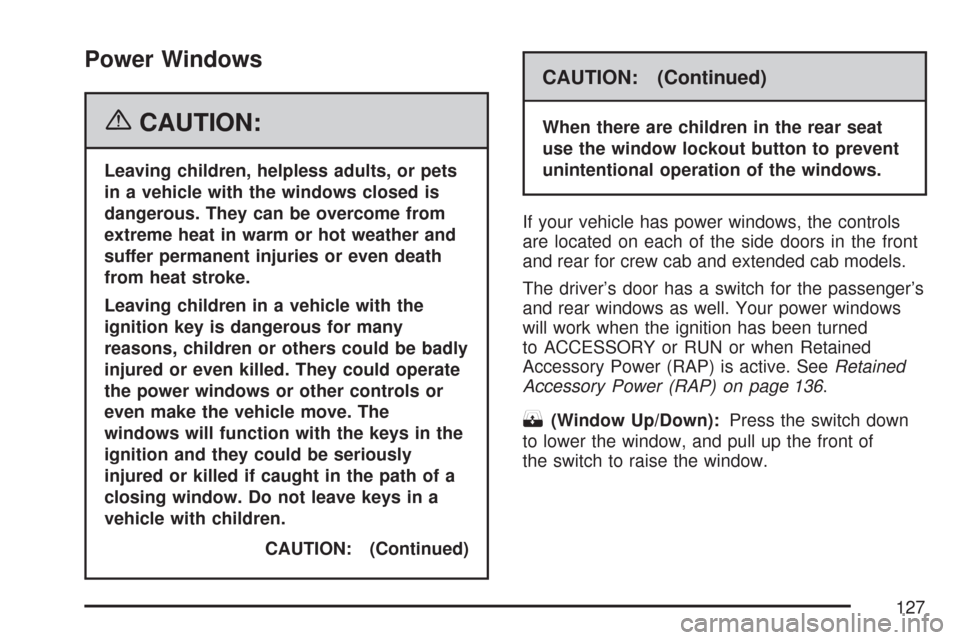
Power Windows
{CAUTION:
Leaving children, helpless adults, or pets
in a vehicle with the windows closed is
dangerous. They can be overcome from
extreme heat in warm or hot weather and
suffer permanent injuries or even death
from heat stroke.
Leaving children in a vehicle with the
ignition key is dangerous for many
reasons, children or others could be badly
injured or even killed. They could operate
the power windows or other controls or
even make the vehicle move. The
windows will function with the keys in the
ignition and they could be seriously
injured or killed if caught in the path of a
closing window. Do not leave keys in a
vehicle with children.
CAUTION: (Continued)
CAUTION: (Continued)
When there are children in the rear seat
use the window lockout button to prevent
unintentional operation of the windows.
If your vehicle has power windows, the controls
are located on each of the side doors in the front
and rear for crew cab and extended cab models.
The driver’s door has a switch for the passenger’s
and rear windows as well. Your power windows
will work when the ignition has been turned
to ACCESSORY or RUN or when Retained
Accessory Power (RAP) is active. SeeRetained
Accessory Power (RAP) on page 136.
K(Window Up/Down):Press the switch down
to lower the window, and pull up the front of
the switch to raise the window.
127
Page 128 of 684
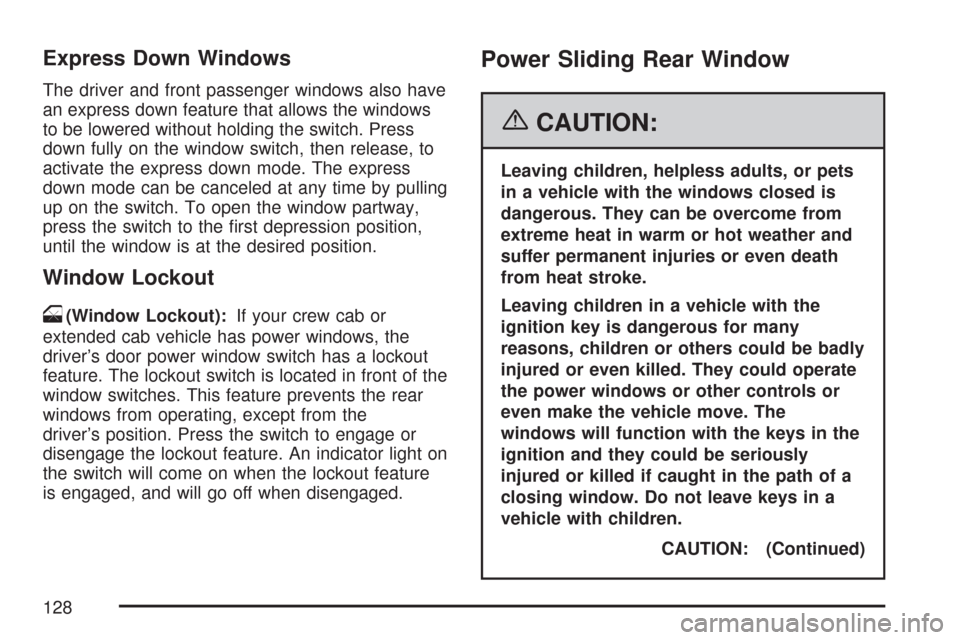
Express Down Windows
The driver and front passenger windows also have
an express down feature that allows the windows
to be lowered without holding the switch. Press
down fully on the window switch, then release, to
activate the express down mode. The express
down mode can be canceled at any time by pulling
up on the switch. To open the window partway,
press the switch to the �rst depression position,
until the window is at the desired position.
Window Lockout
o
(Window Lockout):If your crew cab or
extended cab vehicle has power windows, the
driver’s door power window switch has a lockout
feature. The lockout switch is located in front of the
window switches. This feature prevents the rear
windows from operating, except from the
driver’s position. Press the switch to engage or
disengage the lockout feature. An indicator light on
the switch will come on when the lockout feature
is engaged, and will go off when disengaged.
Power Sliding Rear Window
{CAUTION:
Leaving children, helpless adults, or pets
in a vehicle with the windows closed is
dangerous. They can be overcome from
extreme heat in warm or hot weather and
suffer permanent injuries or even death
from heat stroke.
Leaving children in a vehicle with the
ignition key is dangerous for many
reasons, children or others could be badly
injured or even killed. They could operate
the power windows or other controls or
even make the vehicle move. The
windows will function with the keys in the
ignition and they could be seriously
injured or killed if caught in the path of a
closing window. Do not leave keys in a
vehicle with children.
CAUTION: (Continued)
128
Page 129 of 684
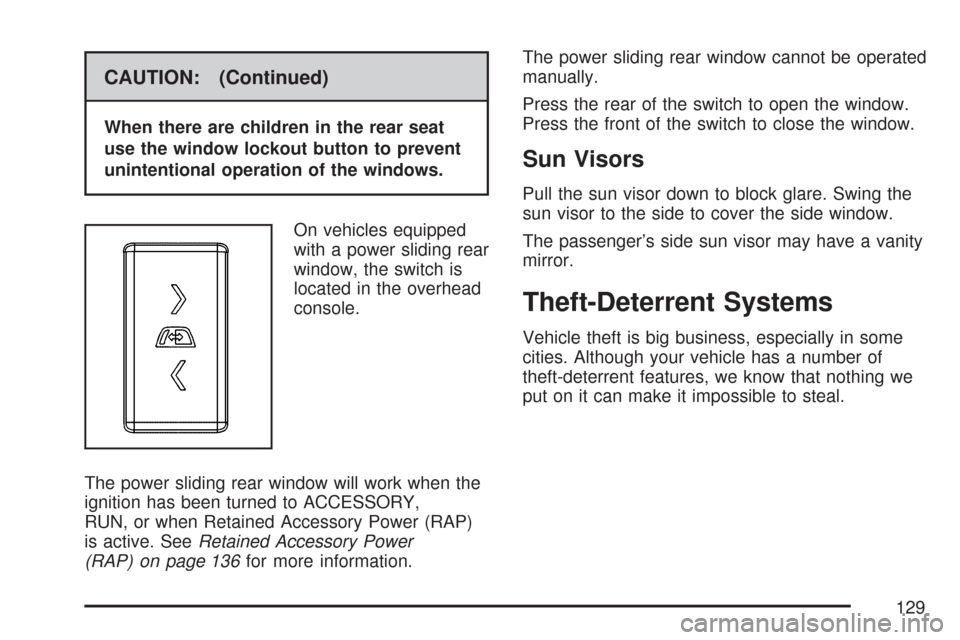
CAUTION: (Continued)
When there are children in the rear seat
use the window lockout button to prevent
unintentional operation of the windows.
On vehicles equipped
with a power sliding rear
window, the switch is
located in the overhead
console.
The power sliding rear window will work when the
ignition has been turned to ACCESSORY,
RUN, or when Retained Accessory Power (RAP)
is active. SeeRetained Accessory Power
(RAP) on page 136for more information.The power sliding rear window cannot be operated
manually.
Press the rear of the switch to open the window.
Press the front of the switch to close the window.
Sun Visors
Pull the sun visor down to block glare. Swing the
sun visor to the side to cover the side window.
The passenger’s side sun visor may have a vanity
mirror.
Theft-Deterrent Systems
Vehicle theft is big business, especially in some
cities. Although your vehicle has a number of
theft-deterrent features, we know that nothing we
put on it can make it impossible to steal.
129
Page 130 of 684
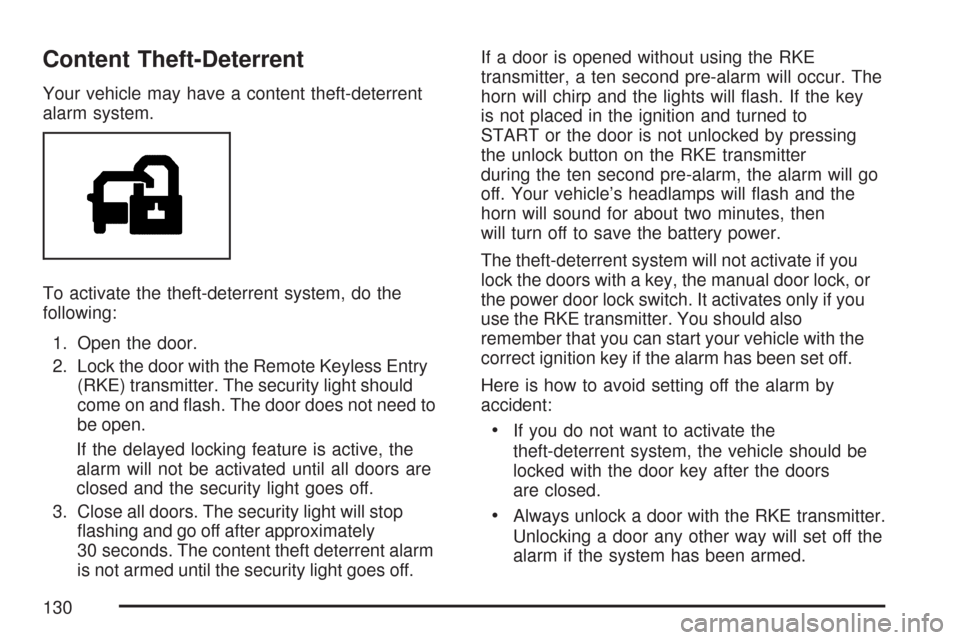
Content Theft-Deterrent
Your vehicle may have a content theft-deterrent
alarm system.
To activate the theft-deterrent system, do the
following:
1. Open the door.
2. Lock the door with the Remote Keyless Entry
(RKE) transmitter. The security light should
come on and �ash. The door does not need to
be open.
If the delayed locking feature is active, the
alarm will not be activated until all doors are
closed and the security light goes off.
3. Close all doors. The security light will stop
�ashing and go off after approximately
30 seconds. The content theft deterrent alarm
is not armed until the security light goes off.If a door is opened without using the RKE
transmitter, a ten second pre-alarm will occur. The
horn will chirp and the lights will �ash. If the key
is not placed in the ignition and turned to
START or the door is not unlocked by pressing
the unlock button on the RKE transmitter
during the ten second pre-alarm, the alarm will go
off. Your vehicle’s headlamps will �ash and the
horn will sound for about two minutes, then
will turn off to save the battery power.
The theft-deterrent system will not activate if you
lock the doors with a key, the manual door lock, or
the power door lock switch. It activates only if you
use the RKE transmitter. You should also
remember that you can start your vehicle with the
correct ignition key if the alarm has been set off.
Here is how to avoid setting off the alarm by
accident:
If you do not want to activate the
theft-deterrent system, the vehicle should be
locked with the door key after the doors
are closed.
Always unlock a door with the RKE transmitter.
Unlocking a door any other way will set off the
alarm if the system has been armed.
130
Page 131 of 684
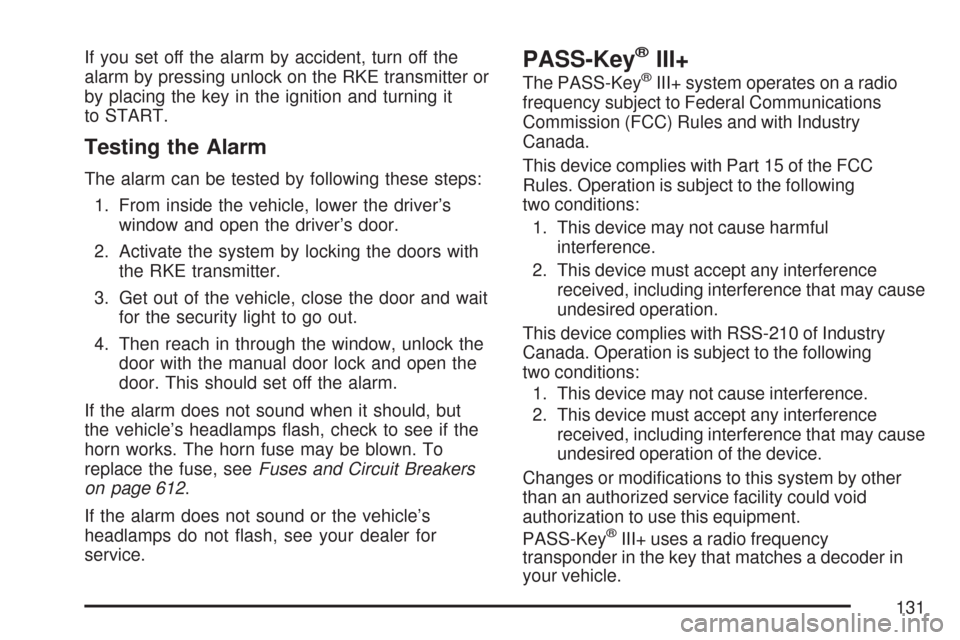
If you set off the alarm by accident, turn off the
alarm by pressing unlock on the RKE transmitter or
by placing the key in the ignition and turning it
to START.
Testing the Alarm
The alarm can be tested by following these steps:
1. From inside the vehicle, lower the driver’s
window and open the driver’s door.
2. Activate the system by locking the doors with
the RKE transmitter.
3. Get out of the vehicle, close the door and wait
for the security light to go out.
4. Then reach in through the window, unlock the
door with the manual door lock and open the
door. This should set off the alarm.
If the alarm does not sound when it should, but
the vehicle’s headlamps �ash, check to see if the
horn works. The horn fuse may be blown. To
replace the fuse, seeFuses and Circuit Breakers
on page 612.
If the alarm does not sound or the vehicle’s
headlamps do not �ash, see your dealer for
service.
PASS-Key®III+
The PASS-Key®III+ system operates on a radio
frequency subject to Federal Communications
Commission (FCC) Rules and with Industry
Canada.
This device complies with Part 15 of the FCC
Rules. Operation is subject to the following
two conditions:
1. This device may not cause harmful
interference.
2. This device must accept any interference
received, including interference that may cause
undesired operation.
This device complies with RSS-210 of Industry
Canada. Operation is subject to the following
two conditions:
1. This device may not cause interference.
2. This device must accept any interference
received, including interference that may cause
undesired operation of the device.
Changes or modi�cations to this system by other
than an authorized service facility could void
authorization to use this equipment.
PASS-Key
®III+ uses a radio frequency
transponder in the key that matches a decoder in
your vehicle.
131
Page 132 of 684

PASS-Key®III+ Operation
Your vehicle has PASS-Key®III+ (Personalized
Automotive Security System) theft-deterrent
system. PASS-Key
®III+ is a passive
theft-deterrent system. This means you do not
have to do anything special to arm or disarm the
system. It works when you transition the key
to RUN, ACCESSORY or START from the OFF
position.
When the PASS-Key
®III+ system senses that
someone is using the wrong key, it prevents the
vehicle from starting. Anyone using a
trial-and-error method to start the vehicle will be
discouraged because of the high number of
electrical key codes.
If the engine does not start and the security light
on the instrument panel cluster comes on
when trying to start the vehicle, the key may have
a damaged transponder. Turn the ignition off
and try again.If the engine still does not start, and the key
appears to be undamaged, try another ignition
key. At this time, you may also want to check the
fuse, seeFuses and Circuit Breakers on
page 612. If the engine still does not start with the
other key, your vehicle needs service. If your
vehicle does start, the �rst key may be faulty. See
your dealer who can service the PASS-Key
®III+
to have a new key made. In an emergency,
contact Roadside Assistance.
It is possible for the PASS-Key
®III+ decoder to
learn the transponder value of a new or
replacement key. Up to nine additional keys may
be programmed for the vehicle. The following
procedure is for programming additional keys only.
If all the currently programmed keys are lost or
do not operate, you must see your dealer or
a locksmith who can service PASS-Key
®III+ to
have keys made and programmed to the system.
132
Page 133 of 684
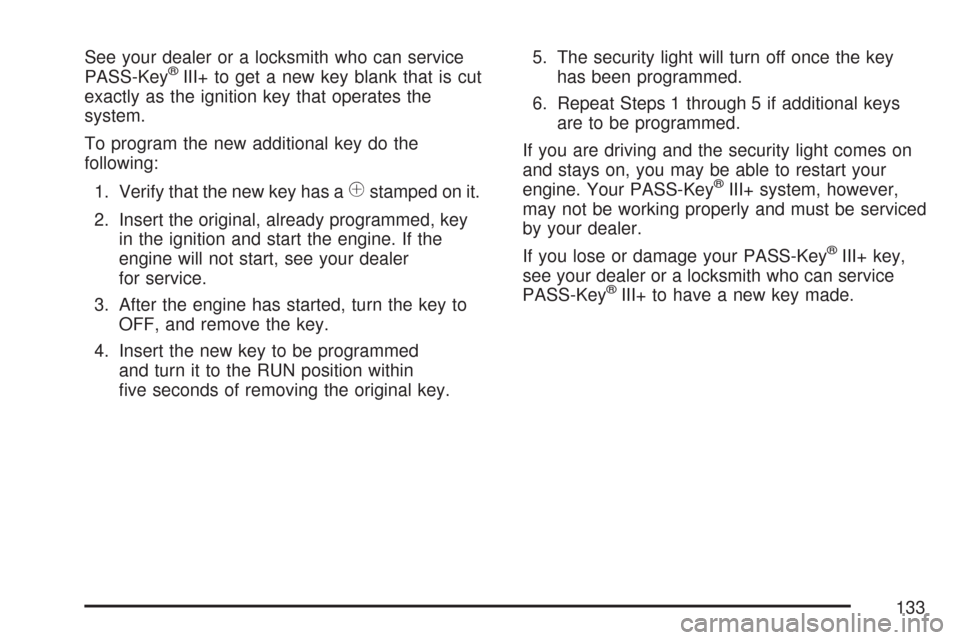
See your dealer or a locksmith who can service
PASS-Key®III+ to get a new key blank that is cut
exactly as the ignition key that operates the
system.
To program the new additional key do the
following:
1. Verify that the new key has a
1stamped on it.
2. Insert the original, already programmed, key
in the ignition and start the engine. If the
engine will not start, see your dealer
for service.
3. After the engine has started, turn the key to
OFF, and remove the key.
4. Insert the new key to be programmed
and turn it to the RUN position within
�ve seconds of removing the original key.5. The security light will turn off once the key
has been programmed.
6. Repeat Steps 1 through 5 if additional keys
are to be programmed.
If you are driving and the security light comes on
and stays on, you may be able to restart your
engine. Your PASS-Key®III+ system, however,
may not be working properly and must be serviced
by your dealer.
If you lose or damage your PASS-Key
®III+ key,
see your dealer or a locksmith who can service
PASS-Key
®III+ to have a new key made.
133
Page 135 of 684
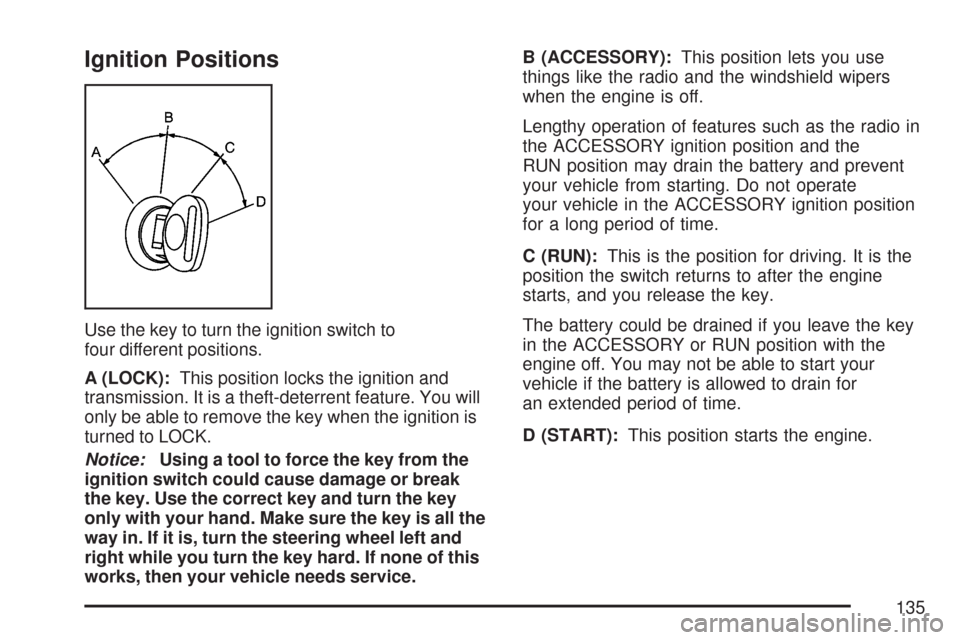
Ignition Positions
Use the key to turn the ignition switch to
four different positions.
A (LOCK):This position locks the ignition and
transmission. It is a theft-deterrent feature. You will
only be able to remove the key when the ignition is
turned to LOCK.
Notice:Using a tool to force the key from the
ignition switch could cause damage or break
the key. Use the correct key and turn the key
only with your hand. Make sure the key is all the
way in. If it is, turn the steering wheel left and
right while you turn the key hard. If none of this
works, then your vehicle needs service.B (ACCESSORY):This position lets you use
things like the radio and the windshield wipers
when the engine is off.
Lengthy operation of features such as the radio in
the ACCESSORY ignition position and the
RUN position may drain the battery and prevent
your vehicle from starting. Do not operate
your vehicle in the ACCESSORY ignition position
for a long period of time.
C (RUN):This is the position for driving. It is the
position the switch returns to after the engine
starts, and you release the key.
The battery could be drained if you leave the key
in the ACCESSORY or RUN position with the
engine off. You may not be able to start your
vehicle if the battery is allowed to drain for
an extended period of time.
D (START):This position starts the engine.
135